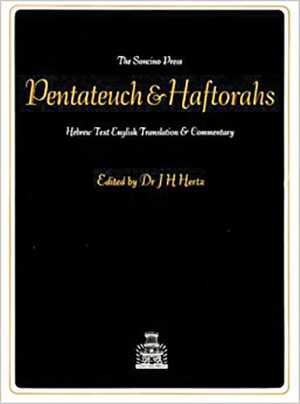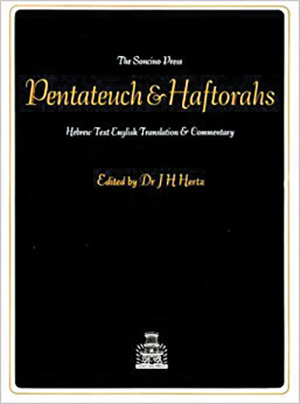
“The Pentateuch and Haftorahs” of Rabbi Dr. J.H. Hertz is one of the most important works of the Jewish religion in the 20th century. To quote one scholar, it “almost single-handedly [gave] shape to the way in which English-speaking Jewish laymen the world over have understood their Judaism over the course of the past two generations.” I recently came across a book that told the story of this work. The book is “A Vindication of Judaism: The Polemics of the Hertz Pentateuch,” by Harvey Meirovich (1998). I learned much from this book, and I would like to share some of it.
First, a bit of biography. Joseph Herman Hertz was born in 1872 in Slovakia. He was brought to the U.S. in 1884 and grew up in New York City on the Lower East Side. He attended City College and Columbia University. He received his rabbinic ordination from the Jewish Theological Seminary in 1894, as part of their first graduating class of eight students. After serving congregations in Syracuse (1894-98), Johannesburg (1898-1911) and New York City (1912), he was appointed chief rabbi of England in 1913. He held that position until his death in 1946.
- Hertz began work on his commentary in 1920. But it was not until 1929 that the first volume came out. The last volume, Deuteronomy, came out in 1936. He did not produce this monumental commentary on his own. He had four Anglo-Jewish collaborators: Joshua Abelson, Abraham Cohen, Gerald Friedlander and Samuel Frampton. Periodically, these men submitted their initial drafts of the sections assigned to them. R. Hertz recast their material into his own style.
What was the background to this work? The author explains it all. In England, in 1901, one year before his move to New York, Solomon Schechter wrote: “[T]he new century does not open under very favourable auspices for Judaism…[O]ur Scriptures are the constant object of attack, our history is questioned, and its morality is declared to be an inferior sort…[T]he younger generation…if not directly hostile, are by dint of mere ignorance sadly indifferent to everything Jewish, and incapable of taking the place of their parents in the Synagogue…” Schechter argued that an English commentary on the Five Books (and the rest of the Bible as well), written under Jewish auspices, was needed to respond to these challenges.
There were already English commentaries on the Five Books before that of R. Hertz, but since they were almost always written by non-Jews, they would typically have an anti-Jewish bias. R. Hertz once remarked about such commentaries: “It is as if a version of Shakespeare were made into Spanish by a Spaniard who had but an imperfect acquaintance with English…and who was filled with hatred and contempt for the British character and the entire British people.”
In his preface, R. Hertz mentions the few and limited English commentaries written by Jews before him: a commentary published in 1844 by De Sola, Lindenthal and Raphall, of which Genesis alone appeared, and commentaries by Marcus Kalisch on Genesis, Exodus and Leviticus, which appeared over the years 1855-72. He also mentions some glosses in English on the Five Books published by David Levi and Isaac Delgado in 1796.
Schechter repeated his plea for a Jewish commentary again after his move to New York in 1902 (when he came to head the Jewish Theological Seminary). The commentary of R. Hertz was a response to the need expressed in Schechter’s plea.
The author explains further that traditional Judaism at the time of R. Hertz was threatened by the late 19th-century biblical criticism of Julius Wellhausen and by its reconstruction of history, which characterized Jewish law as anachronistic, as compared with Christianity’s emphasis on faith and morality. Also, R. Hertz was troubled by the mounting self-confidence of liberal/Reform Judaism. The work of R. Hertz should be read as a reaction to these challenges.
In his preface, R. Hertz makes the following remark: ”[T]he criticism of the Pentateuch associated with the name of Wellhausen is a perversion of history and a desecration of religion.” Using archaeology and philology, R. Hertz crafted a sophisticated work that attempted to underscore the Divinity and unity of the Torah, and the integrity of Judaism and its moral superiority to Christianity.
Aside from the need for a commentary on the Five Books written under Jewish auspices to defend and promote traditional Judaism, there was the more practical need for a commentary that could be used in the synagogue. Before the commentary of R. Hertz, if an English-speaking Jew wanted to follow the Torah reading in shul with one work in his hand that included a Hebrew text of the entire Chumash, an English translation and any kind of English commentary, there was no such work! As we walk into our shuls with hundreds of ArtScroll and Hertz Chumashim, this is hard for us to imagine! (On the very unlikely chance that there was such a work, the commentary would have been written by a non-Jew, and it certainly would not have been divided into parshiyot, let alone include haftarot!)
While R. Hertz’ work was completed before the Holocaust, it became even more useful thereafter, as the destruction of European Jewry shifted the center of gravity in Jewish life to the English-speaking world. As one scholar wrote: “Hertz had forged in advance for the Jews of England and America a tool to sustain their fortitude and faith.”
The two most interesting discussions in the book are the story of the complaint of his collaborators, and the story of how R. Hertz’ work did not sell well initially, despite the tremendous amount of work that went into it.
With regard to the collaborators, on July 8, 1929, after Genesis came out, three of his four collaborators (the other one was already deceased) wrote a letter of complaint about how their names were not included on the title page, even though he did acknowledge their assistance in the introduction. They wrote: “On the title page of the Commentary the names of your collaborators do not appear. In all similar works, proper tribute is paid in this way to those who have collaborated, as for instance in Kittel’s ‘Biblia Hebraica.’ Accordingly, we feel strongly that following the words: ‘Edited by the Chief Rabbi’ some such phrase as ‘With the collaboration of…’ should certainly follow. We do not consider that our point is covered by the bare reference in the Introduction. We submit that in the subsequent volumes, and also when a new edition of Genesis appears, we should be favored in the way indicated.”
- Hertz wrote back: “[N]othing is further from my nature than to deprive others of the honour which is justly their due….Your complaint, moreover, is unjustified. The English usage in regard to any collective enterprise of a literary nature is that only the editor’s name appears. (The example of Kittel’s Bible is not an analogous case). An absolute parallel case is…..Such is the rule when the contribution of each man is reprinted as it is, without any recasting on the part of the editor. How much the more should it apply in a case where the contributions have been recast and often altogether rewritten by the editor!”
Genesis sold very poorly initially, causing R. Hertz extreme disappointment. He even considered canceling the publication of the remaining volumes! But people were hesitant to buy the single volumes in view of the anticipated publication of the entire five books in one work. In 1936, the Soncino Press approached him, as they understood that tremendous sales would result by combining the five volumes into one. Also, a large donation by a friend of R. Hertz enabled the work to be sold at a much lower price. (The Soncino edition also changed the text used for the English translation at the top. Instead of the revised King James version, the more readable 1917 Jewish Publication Society translation was chosen. I admit that, until I prepared this column, I had always assumed that the translation was by R. Hertz himself!) With the Soncino Press edition, sales took off and the work became the mainstay of English-speaking synagogues of every denomination for decades. (Another English option did not appear until 1981 when the Reform movement published its own Chumash.)
For another interesting article on the Hertz Chumash, see the article by Yosef Lindell, of May 29 2017, at www.thelehrhaus.com.
By Mitchell First
Mitchell First is a personal injury attorney and Jewish history scholar. His most recent book is “Esther Unmasked: Solving Eleven Mysteries of the Jewish Holidays and Liturgy” (Kodesh Press, 2015). He can be reached at MFirstAtty@aol.com.
For more articles by Mitchell First, and information on his books, please visit his website at rootsandrituals.org.










